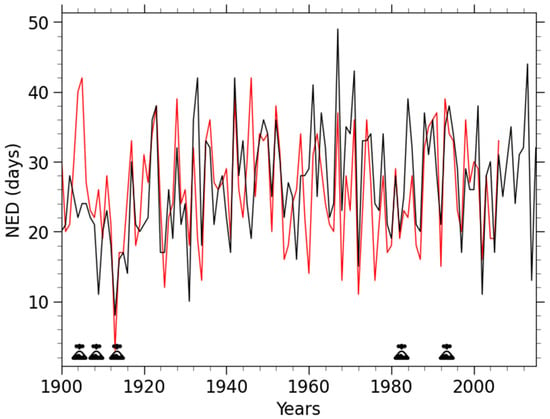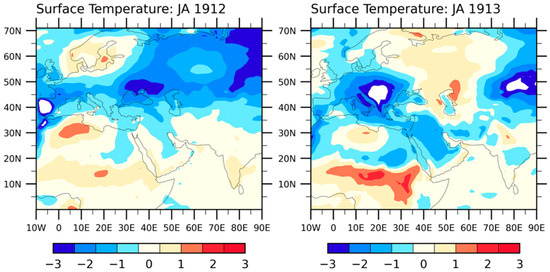Abstract
The Etesian winds characterize the summertime circulation in the Eastern Mediterranean. Etesians are modulated by the Indian summer monsoon (ISM), but their response to other external forcings is not understood. Here, we investigate the response of Etesians to the Novarupta/Katmai 1912 volcanic eruption with the aid of 20th Century reanalysis and station-based wind observations. We demonstrate a robust reduction in the total number of days with Etesian winds in July and August 1913. We also detect a strong cooling and weakened surface pressure gradients in the Eastern Mediterranean, which explains the decline in Etesian winds in the post-eruption summer.
1. Introduction
Etesian winds characterize the summertime circulation in the Eastern Mediterranean (EMed) [1]. Etesians exhibit a strong seasonal variation, with the strongest wind speeds in July and August. This has been attributed to the synchronization with the development of the Indian summer monsoon (ISM) [2,3]. A stronger ISM favors adiabatic heating in the EMed, which is balanced via cooling caused by stronger Etesian wind speeds.
Misios et al. [4] investigated the role of major volcanic eruptions over the last millennium (850–2005) on the Etesians in the CESM Last Millennium simulations. They identified anomalously colder summers in the Mediterranean one to two years after strong eruptions, a cooling that maximizes in the EMed. Volcanic eruptions are found to impact sea level pressure (SLP), particularly over the Anatolian low. This reduces SLP gradients over the Aegean Sea, which in turn reduces wind speeds and the number of days with Etesians in the first summer after the eruption. Misios et al. [4] identified some aspects of the simulated responses in the case of the Pinatubo 1991 eruption, although of low statistical significance. Motivated by the stronger sensitivity to high-latitude eruptions in the Northern Hemisphere, here, we investigate possible changes in the Etesian winds in the summers following the Novarupta (Katmai) eruption in Alaska (58° N) in June 1912 [5], which is the strongest high-latitude eruption of the 20th century. It is estimated that Katmai injected about 5 megatons (Mt) of SO2 into the stratosphere, which was confined to the Northern Hemisphere [6]. This compares to a stratospheric loading for the Mount Pinatubo eruption.
2. Data and Methods
2.1. 20th Century Reanalysis and L Days
We analyzed circulation changes using the NOAA–CIRES–DOE 20th Century Reanalysis project (20CR hereafter) [7]. Etesian winds in 20CR were compared with station wind observations. This was confirmed by comparing 20CR with the L days dataset of Carapiperis [8]. The correlation between the number of Etesian days (see Section 2.2) from the 20CR dataset and the L days index over the common 1900–2006 period is significant (r = 0.59, p < 0.01 based on a two-tailed t-test; see Figure 1).

Figure 1.
Time series of the July–August NED (days) over the 1900–2015 period in 20CR (black) and L days (red). Black volcano symbols indicate major volcanic eruptions.
2.2. Definition of Days with Etesian Winds
We calculated daily wind speed (WSP) and wind direction (WDIR) during the late summer (July and August, JA hereafter) at a fixed grid point (37.5° N, 25.0° E) in the central Aegean Sea. Following the methodology of Misios et al. [4], a day with Etesians occurs when the following criteria are satisfied: (a) WDIR is between NW (315°) and NE (45°), (b) daily WSP exceeds its long-term median, and (c) criteria (a) and (b) are fulfilled for at least 2 consecutive days. Finally, we count the number of Etesian days (NED) for every JA season.
3. Results
3.1. Number of Etesian Days over the 20th Century
We first analyze the time series of NED from 1900 onwards using the 20CR reanalysis and the L days (Figure 1). The 20CR agrees well with the empirical L-day index, both capturing the years of the weakened number of Etesian days. One such example is the summer of 2014, which has been analyzed by Tyrlis et al. [9], but the most notable reduction is identified in the summer of 1913. This summer experienced a collapse of Etesian winds as the number of days with Etesian winds hardly exceeded 2 or 8 days in the L days and 20CR, respectively. This is a very pronounced decline indicative of a summer essentially without Etesians.
It is interesting to note that this collapse happened the summer following the Katmai/Novarupta eruption in Alaska, which prompts for an examination of the surface conditions in the summer of 1913.
3.2. The EMed Summer after the Katmai Eruption
The Northern Hemisphere surface temperature cooled by about 0.5 K in the summer of 1912 because of the elevated concentration of stratospheric aerosols, which efficiently block the incoming short-wave radiation. The cooling also persisted in the following summer but with notable spatial differences. Figure 2 shows the surface temperature anomalies in JA 1912 and 1913 in relation to the mean 1918–1940 climatology. There is a widespread cooling over Europe and Asia that weakens in the following year. Yet, the surface cooling over the Balkans, Greece, and Southern Eastern Mediterranean is amplified in the summer of 1913, exceeding −3 K anomalies. In contrast to the overall cooling, an area of significant warming stands out over Central Africa.

Figure 2.
Surface temperature anomalies in the summers (July–August mean) of 1912 and 1913.
The surface cooling in the two summers after the eruption is associated with an increased SLP in the EMed and Anatolian low, particularly in the summer of 1913 (Figure 3) that exceeds 3 hPa. This SLP pattern suggests a reduced SLP gradient over the Aegean Sea, which should cause weaker wind speeds as evidenced by the southerly anomalies of about 2 ms−1 (arrows in Figure 3). Hence, as discussed in the previous section, fewer days with Etesians are expected. Similar patterns of a forced response to volcanic eruptions have also been simulated with climate models [4,10].

Figure 3.
Surface pressure and 10 m wind anomalies in the summers (July–August mean) of 1912 and 1913.
4. Summary
Previous model simulations for the Katmai eruption found a large radiative cooling over the landmasses during the post-eruption summer in EMed [6]. Here, using the 20CR, we demonstrate a strong surface cooling and changes in the SLP pattern, which affect Etesian winds in the summer of 1913. These findings have been supported by analyzing strong eruptions in the Last Millennium model simulations. Misios et al. [4] provided a mechanism through which a high altitude eruption weakens ISM, reduces upwelling in the ISM branch, and subsequently weakens the descending branch in the EMed region. This weakens SLP gradients between Central Europe/Balkans and the Anatolian region and thus reduces Etesian winds. The 20CR reanalysis provides similar evidence for the high-latitude Katmai eruption, which prompts for further investigation on the ISM–Etesian winds connection using ensemble simulations with a global climate model.
Author Contributions
Conceptualization, S.M. and V.A.; formal analysis, S.M.; writing—review and editing, S.M. and V.A. All authors have read and agreed to the published version of the manuscript.
Funding
This research was funded by the H2020 Marie Skłodowska-Curie Action “Climatic impacts of volcanic ash electrification-ElectricVolcano” (grant no. 895461).
Institutional Review Board Statement
Not applicable.
Informed Consent Statement
Not applicable.
Data Availability Statement
Data are available upon request.
Conflicts of Interest
The authors declare no conflict of interest.
References
- Tyrlis, E.; Lelieveld, J. Climatology and Dynamics of the Summer Etesian Winds over the Eastern Mediterranean. J. Atmos. Sci. 2013, 70, 3374–3396. [Google Scholar] [CrossRef]
- Rodwell, M.J.; Hoskins, B.J. Subtropical anticyclones and summer monsoons. J. Clim. 2001, 14, 3192–3211. [Google Scholar] [CrossRef]
- Logothetis, I.; Tourpali, K.; Misios, S.; Zanis, P. Etesians and the summer circulation over East Mediterranean in Coupled Model Intercomparison Project Phase 5 simulations: Connections to the Indian summer monsoon. Int. J. Climatol. 2019, 40, 1118–1131. [Google Scholar] [CrossRef]
- Misios, S.; Logothetis, I.; Knudsen, M.F.; Karoff, C.; Amiridis, V.; Tourpali, K. Decline in Etesian winds after large volcanic eruptions in the last millennium. Weather Clim. Dynam. 2022, 3, 811–823. [Google Scholar] [CrossRef]
- Hildret, W.; Fierstein, J. The Novarupta-Katmai Eruption of 1912—Largest Eruption of the Twentieth Century: Centennial Perspectives; U.S. Department of the Interior, U.S. Geological Survey: Reston, VA, USA, 2012.
- Oman, L.; Robock, A.; Stenchikov, G.; Schmidt, G.A.; Ruedy, R. Climatic response to high-latitude volcanic eruptions. J. Geophys. Res. Atmos. 2005, 110, D13103. [Google Scholar] [CrossRef]
- Slivinski, L.C.; Compo, G.P.; Whitaker, J.S.; Sardeshmukh, P.D.; Giese, B.S.; McColl, C.; Allan, R.; Yin, X.G.; Vose, R.; Titchner, H.; et al. Towards a more reliable historical reanalysis: Improvements for version 3 of the Twentieth Century Reanalysis system. Q. J. Roy. Meteorol. Soc. 2019, 145, 2876–2908. [Google Scholar] [CrossRef]
- Carapiperis, L.N. On the Periodicity of the Etesians in Athens. Weather 1951, 6, 378–379. [Google Scholar] [CrossRef]
- Tyrlis, E.; Tymvios, F.S.; Giannakopoulos, C.; Lelieveld, J. The role of blocking in the summer 2014 collapse of Etesians over the eastern Mediterranean. J. Geophys. Res. Atmos. 2015, 120, 6777–6792. [Google Scholar] [CrossRef]
- Dogar, M.M.; Sato, T. A Regional Climate Response of Middle Eastern, African, and South Asian Monsoon Regions to Explosive Volcanism and ENSO Forcing. J. Geophys. Res.-Atmos. 2019, 124, 7580–7598. [Google Scholar] [CrossRef]
Disclaimer/Publisher’s Note: The statements, opinions and data contained in all publications are solely those of the individual author(s) and contributor(s) and not of MDPI and/or the editor(s). MDPI and/or the editor(s) disclaim responsibility for any injury to people or property resulting from any ideas, methods, instructions or products referred to in the content. |
© 2023 by the authors. Licensee MDPI, Basel, Switzerland. This article is an open access article distributed under the terms and conditions of the Creative Commons Attribution (CC BY) license (https://creativecommons.org/licenses/by/4.0/).